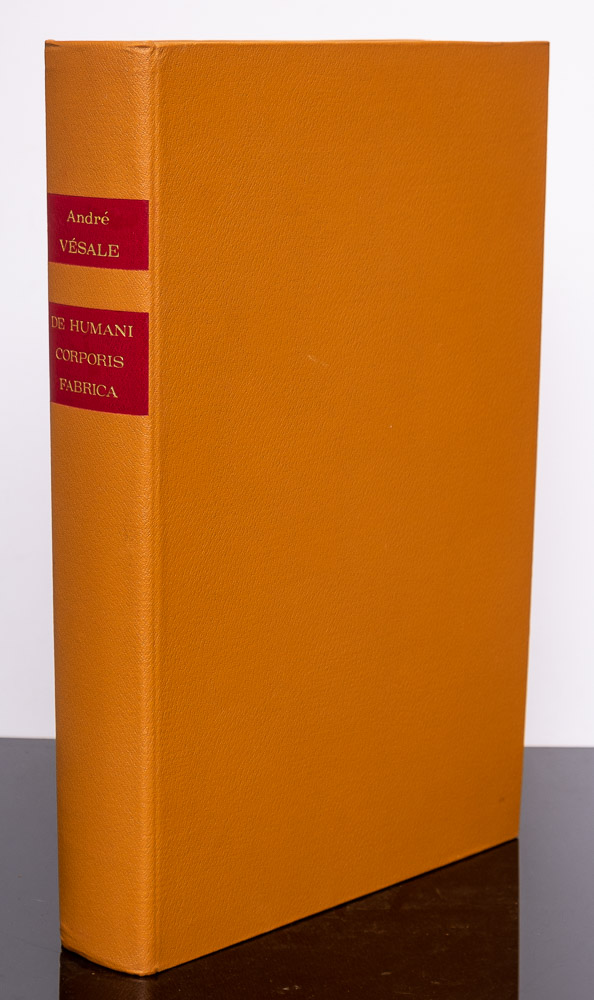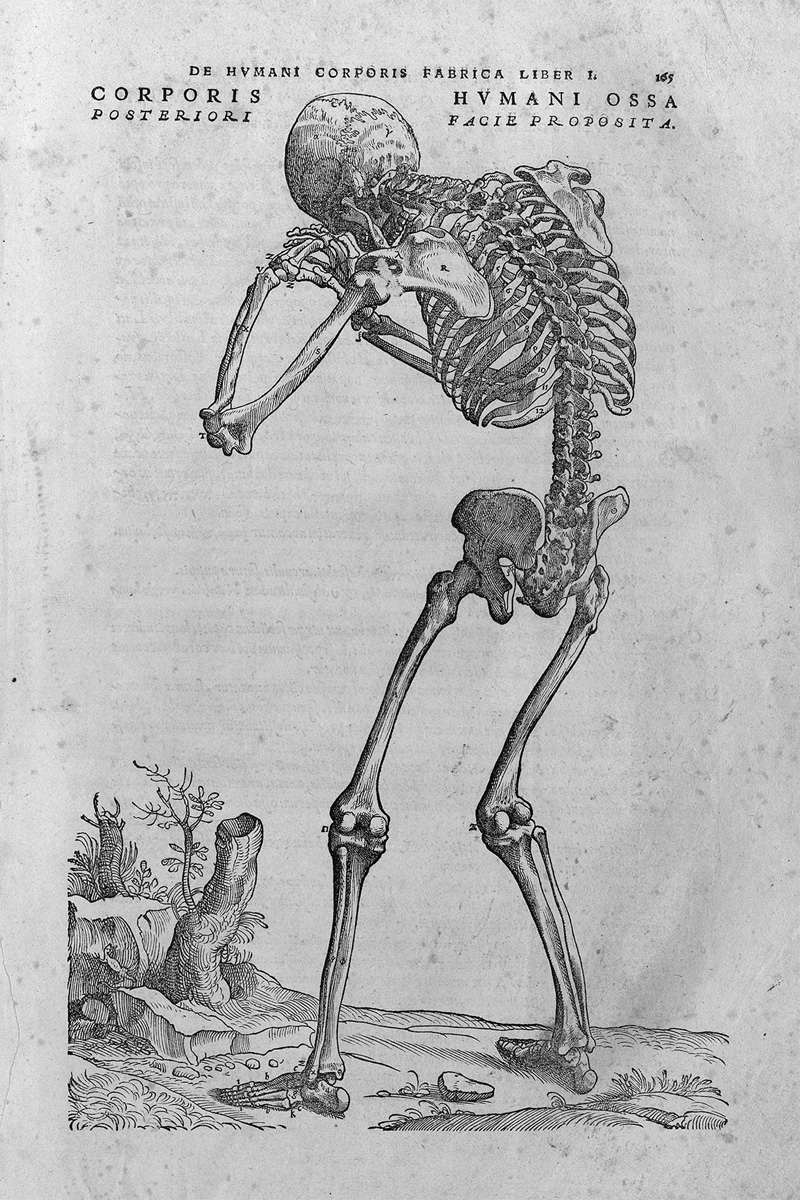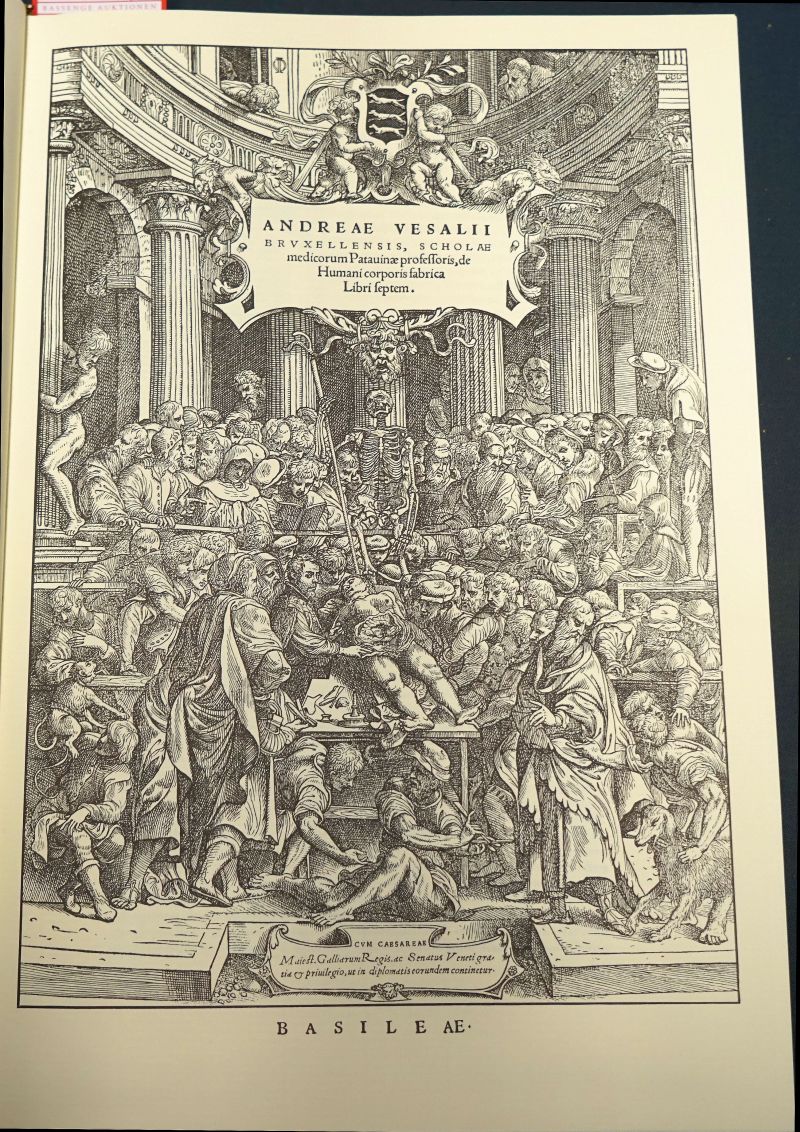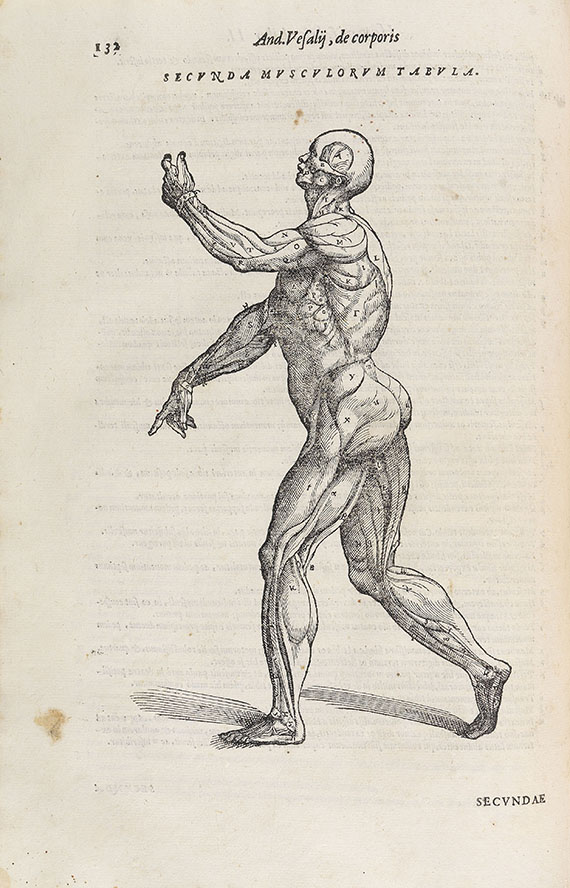VESALIUS, Andreas (1514-64). De humani corporis fabrica libri septem. Basel: Johannes Oporinus, August 1555. Large 2 o (438 x 284mm). Collation: a-z 6 A-T 6 V 6(6 + fold-out sheet signed X, 6+1 signed X2) Y-Z 6 aa 6 bb 6(5 + 1 fold-out sheet) cc-zz 6 Aa 8 Bb-Ee 6. 441 leaves and 2 folding sheets. Roman and italic types, occasional use of Greek and Hebrew types, printed shoulder notes. Woodcut pictorial title, author's portrait, and printer's device; 9 large woodcut initials, 183 mid-sized woodcut initials, 22 small woodcut initials; more than 200 woodcut illustrations, including 3 full-page skeletons, 14 full-page muscle-men, 5 large diagrams of veins and nerves, 10 mid-sized views of the abdomen, 2 mid-sized views of the thorax, 13 mid-sized views of the skull and brain, and numerous smaller views of bones, organs and anatomical parts. (A few mostly marginal wormholes in first and last quires touching a few letters in index; lower corner of title page restored to remove inscription not touching woodcut or imprint; faint stain in quires Cc-Ee.) Binding : Contemporary Wittenberg blind-tooled pigskin over bevelled-edge wooden boards by FROBENIUS HEMPEL (d. 1575): heads-in- medallion roll (Haebler 4); vertical Biblical roll signed FH incorporating the Crucifixion, Annunciation and Resurrection (Haebler 2); horizontal Biblical roll signed FH, incorporating the creation of Eve, a reclining figure, and Jacob's Ladder (Haebler 3); individual subjects from this roll used as vignettes above and below the central plaque on each cover; large pictorial plaque blocked in the center of each cover, the front plaque signed FH, depicting Fides and Spes (Haebler VI); the back center plaque depicting Charity with a beggar (Haebler XIII); original twisted brass clasps, later (17th-century) lettering-pieces on spine (minor wear, a few small wormholes); modern black morocco box. Provenance : initials and date "G F V 1567" gilt-stamped on front cover; copy of the letter of Hubert Languet (1518-81) to Caspar Peucer, 1 January 1565, describing the supposed circumstances of Vesalius's pilgrimage to the Holy Land at the end of his life (16th-century note on front pastedown, remains of red wax seal below; text translated in O'Malley, p. 304); additional notes referring to Vesalius' supposed dissection of a still-living body, from Par and Dudits (16th-century notes on front flyleaf; cf. O'Malley, p. 305); Wenceslaus Meixner, gift to Benedict Waltenberger, abbot "Zabrdovicensi" (17th-century inscription on pastedown); F.G, abbot of "Zabrdovicensi", gift to Philip Caspar Schaf, doctor of medicine in Moravia, 18 February 1652 (inscription, a2r); ?Olmtz, Praemonstratensians of Hradisko ("Conventus Gradiensis", 17th-century inscription on title, their labels on three lettering-pieces added to spine). Third edition, SECOND FOLIO EDITION. The second folio edition of De humani corporis fabrica was, like the first, printed by Johannes Oporinus in Basel. The text, incorporating Vesalius' final revisions, was reset in larger type, with 49 instead of 50 lines to the page, and was printed on larger and heavier paper. The initials were recut to fit the new type size, and the frontipiece was also recut with several differences of detail. The anatomical illustrations, however, and the portrait of Vesalius were reprinted from the 1543 woodblocks. The text transcribed on the pastedown of this copy is of some interest for the growth of Vesalius' legend. After the abdication of Charles V, Vesalius entered the service of Philip II, spending the latter years of his career in Spain. In 1564 he undertook a trip to Jerusalem, but died unexpectedly on the way back, and was buried in an unmarked grave on the island of Zante. The supposed reason for his journey was given in a letter allegedly written by Hubert Languet, a distinguished publicist and diplomat, to Caspar Peucer, physician and son-in-law of Philip Melanchthon, in which he claimed to have heard from correspondents
VESALIUS, Andreas (1514-64). De humani corporis fabrica libri septem. Basel: Johannes Oporinus, August 1555. Large 2 o (438 x 284mm). Collation: a-z 6 A-T 6 V 6(6 + fold-out sheet signed X, 6+1 signed X2) Y-Z 6 aa 6 bb 6(5 + 1 fold-out sheet) cc-zz 6 Aa 8 Bb-Ee 6. 441 leaves and 2 folding sheets. Roman and italic types, occasional use of Greek and Hebrew types, printed shoulder notes. Woodcut pictorial title, author's portrait, and printer's device; 9 large woodcut initials, 183 mid-sized woodcut initials, 22 small woodcut initials; more than 200 woodcut illustrations, including 3 full-page skeletons, 14 full-page muscle-men, 5 large diagrams of veins and nerves, 10 mid-sized views of the abdomen, 2 mid-sized views of the thorax, 13 mid-sized views of the skull and brain, and numerous smaller views of bones, organs and anatomical parts. (A few mostly marginal wormholes in first and last quires touching a few letters in index; lower corner of title page restored to remove inscription not touching woodcut or imprint; faint stain in quires Cc-Ee.) Binding : Contemporary Wittenberg blind-tooled pigskin over bevelled-edge wooden boards by FROBENIUS HEMPEL (d. 1575): heads-in- medallion roll (Haebler 4); vertical Biblical roll signed FH incorporating the Crucifixion, Annunciation and Resurrection (Haebler 2); horizontal Biblical roll signed FH, incorporating the creation of Eve, a reclining figure, and Jacob's Ladder (Haebler 3); individual subjects from this roll used as vignettes above and below the central plaque on each cover; large pictorial plaque blocked in the center of each cover, the front plaque signed FH, depicting Fides and Spes (Haebler VI); the back center plaque depicting Charity with a beggar (Haebler XIII); original twisted brass clasps, later (17th-century) lettering-pieces on spine (minor wear, a few small wormholes); modern black morocco box. Provenance : initials and date "G F V 1567" gilt-stamped on front cover; copy of the letter of Hubert Languet (1518-81) to Caspar Peucer, 1 January 1565, describing the supposed circumstances of Vesalius's pilgrimage to the Holy Land at the end of his life (16th-century note on front pastedown, remains of red wax seal below; text translated in O'Malley, p. 304); additional notes referring to Vesalius' supposed dissection of a still-living body, from Par and Dudits (16th-century notes on front flyleaf; cf. O'Malley, p. 305); Wenceslaus Meixner, gift to Benedict Waltenberger, abbot "Zabrdovicensi" (17th-century inscription on pastedown); F.G, abbot of "Zabrdovicensi", gift to Philip Caspar Schaf, doctor of medicine in Moravia, 18 February 1652 (inscription, a2r); ?Olmtz, Praemonstratensians of Hradisko ("Conventus Gradiensis", 17th-century inscription on title, their labels on three lettering-pieces added to spine). Third edition, SECOND FOLIO EDITION. The second folio edition of De humani corporis fabrica was, like the first, printed by Johannes Oporinus in Basel. The text, incorporating Vesalius' final revisions, was reset in larger type, with 49 instead of 50 lines to the page, and was printed on larger and heavier paper. The initials were recut to fit the new type size, and the frontipiece was also recut with several differences of detail. The anatomical illustrations, however, and the portrait of Vesalius were reprinted from the 1543 woodblocks. The text transcribed on the pastedown of this copy is of some interest for the growth of Vesalius' legend. After the abdication of Charles V, Vesalius entered the service of Philip II, spending the latter years of his career in Spain. In 1564 he undertook a trip to Jerusalem, but died unexpectedly on the way back, and was buried in an unmarked grave on the island of Zante. The supposed reason for his journey was given in a letter allegedly written by Hubert Languet, a distinguished publicist and diplomat, to Caspar Peucer, physician and son-in-law of Philip Melanchthon, in which he claimed to have heard from correspondents















Testen Sie LotSearch und seine Premium-Features 7 Tage - ohne Kosten!
Lassen Sie sich automatisch über neue Objekte in kommenden Auktionen benachrichtigen.
Suchauftrag anlegen